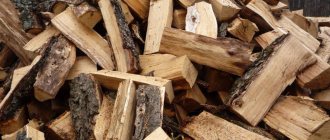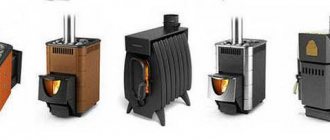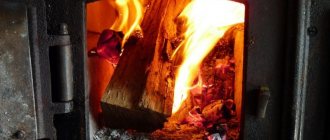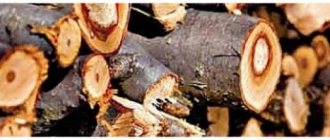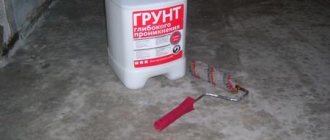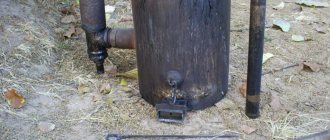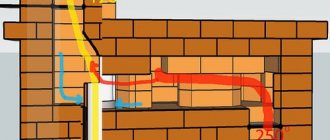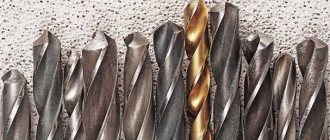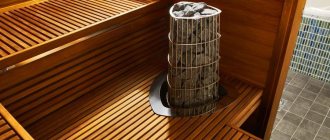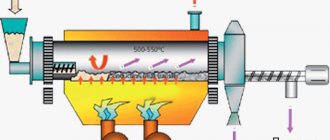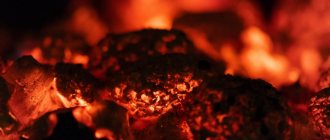The stove always served faithfully, but suddenly it started smoking. This is especially often observed when opening the ash pit or when the owner adds a new batch of firewood.
What is the reason why the stove smokes when the door is opened and how to properly heat it so that the smoke does not enter the living room. The most common reasons and advice from experienced stove makers.
Backdraft - Temperature and Humidity
Why does the stove smoke into the house?
The natural extraction of flue gases through the chimney is based on the laws of physics. Of primary importance here are the temperatures indoors and outdoors, as well as the difference between them.
Poor traction is the scourge of warm weather in the off-season. For example, after a summer of inactivity, it takes special skill to light the stove in the fall so that smoke does not enter the house.
Also, the air can “stay” even in cold weather if the owners left the house and it froze. If the temperatures inside and outside are equal, there will be no draft.
Humidity can also play a role. For example, when slanting downpours occur and water enters the pipe, this upsets the temperature balance and the draft worsens.
In warm weather, or in a frozen house, paper is burned for kindling. It needs to be placed as far into the oven as possible; if this does not help, then into the far well through the cleaning door. Closer to the pipe, make a small fire made of paper or small wood chips. This is necessary in order to warm up the brick. Warm air will rise and draft will be established.
In hot weather, it is extremely difficult to establish traction.
Where to start checking the furnace?
Smoke comes out of the house, and you need to start checking from the roof - from the chimney. If the draft was good, but suddenly stopped, the cause may be an object that blocked the pipe. This happens especially often if there is no cap over the chimney and there are tall trees nearby. Any object can mechanically narrow the chimney channel: a nest made by birds, a brick falling out of the chimney, an accumulation of branches, debris.
If there is no cap, the draft also disappears during strong winds. The air mass creates a turbulence in the pipe and blocks the path of smoke. It comes back and exits through the latches and doors. In calm weather there is no smoke in the house, and from this sign you can already understand its cause.
Wind
A temporary cause of backdraft can be the wind, the direction and strength of which “drives” the smoke back into the chimney. Tall trees or buildings located near the house can contribute to this.
Install an umbrella or deflector on the top edge of the pipe. These devices significantly improve draft, protect from rain and prevent the wind from blowing smoke back into the chimney.
To date, many deflector designs have been developed. There are rotating models that are themselves installed by the force of the wind so that there is no interference with the smoke.
Many people are interested in the question: how to line an iron stove with bricks? Read useful information in our article. For information on self-repair of Ariston water heaters, see here.
Read about winter kits for air conditioners at this link.
Application of technical means
To increase the traction force, you can resort to methods that do not involve changing the design of the chimneys. There are several types of different technical solutions that can be installed directly on the finished pipe.
One of them is the rotary turbine. Essentially, this is a fan that, due to the force of the wind, draws smoke from the chimney. True, it has a slight limitation on the temperature of the outlet stream. It should not exceed 200 degrees. Therefore, such solutions are used mainly to increase thrust in gas structures. A special tip that is able to turn the area where the smoke exits away from the wind can also help increase draft. Its operation is based on the operation of a conventional weather vane. In addition, its design is made in such a way as to avoid moisture getting inside the pipe.
The use of special electric smoke exhausters with an increase in draft force will be a good solution for private houses in windy areas. These devices are a fan that operates using electrical energy and physically “pulls” smoke out of the chimney.
Incorrect laying of a stove or well
An important condition for good smoke removal is sufficient chimney clearance. The pipe must be at least 15 cm in diameter (for a sauna stove - 10 cm).
During laying, the stove maker rubs the inner surface of all wells and pipes with a damp rag. If possible, all sharp internal corners are trimmed and turns are smoothed out. This creates a smooth inner surface along which smoke can easily move upward. This is done as the furnace is being laid. But you cannot plaster the inside of chimneys.
Any turn or additional well is another obstacle in the path of smoke. Therefore, the length of the pipe and its location on the roof must be adequately designed for the design of a particular stove.
It is also important that the entrance to the first well (inside the firebox) is not lower than the top edge of the door. Otherwise, there is a possibility that every time the fuel chamber is opened, smoke will flow into the room.
The stove maker's mistakes come at a cost. Something in the design can be corrected only by moving part of the stove, or maybe by completely rebuilding it.
A tall, straight pipe with a smooth inner surface can be a salvation if minor miscalculations are made and the draft is weak:
- If located close to the ridge, the pipe should be at least 50 cm higher than it.
- When located 1.5 - 3 m from the ridge, the height of the pipe is allowed to be level with the ridge or higher.
- The pipe can only be slightly lower than the ridge if it is located more than 3 m from it.
- A chimney height of 5 m or more is capable of providing full draft.
- Under no circumstances should the chimney be assembled from elements of different sections!
It is advisable to make a pipe with a round cross-section. In the corners of rectangular smoke extractors, unnecessary turbulence is created, and soot formation occurs more readily.
Metal pipes “suffer” from deteriorating traction more often than brick and asbestos pipes. This happens because the metal heats up quickly and cools down just as quickly on a frosty day. Insulation with non-flammable material saves the situation.
Soot adhesion
The most common source of deterioration in draft is the adhesion of soot on the walls of the chimney. The internal diameter of the pipe becomes so narrow that smoke, accumulating, exits through any cracks in the unit body. The degree of soot adhesion does not depend on the location of the stove: in a bathhouse or in a house. Incorrect operation and certain types of burned wood contribute more to its formation. The first factor is insufficient, and the second is the burning of coniferous logs. The only way to repair in this case is to clean the chimney.
How to clean a chimney?
The mechanical cleaning method requires special devices:
- ruff, cable, weight.
First, a weight attached to a cable is lowered into the chimney. This way you can find an obstacle or a place where the pipe has narrowed. If it is necessary to push through any object that has blocked the channel, the weight is thrown down with force. At the next stage, the pipe is cleaned with a brush. It has the shape of a square or round brush, its dimensions should be slightly larger than the pipe hole. Using down/up movements, the chimney is cleared of soot and accumulated small debris.
Soot and furnace wear
Why does the stove smoke in a private house? Other reasons
Even if the stove was perfect at the construction stage, over time the chimney clearance may narrow due to the build-up of soot. This is an inevitable process, so the oven is cleaned regularly. However, without wanting it, owners can significantly speed up the soot formation process.
What mistakes should you avoid:
- Do not use wet firewood, especially resinous wood.
- Do not over-burn large amounts of synthetic waste in the oven (cellophane, plastic, rags, rubber...).
- During the construction stage, do everything possible to ensure that the inner surface of the stove does not have protrusions, is smooth and uniform.
- Do not try to convert a regular oven into a pyrolysis oven.
Thrifty owners often strive to do the latter in order to save money. They limit the air supply, without opening the vent, but leaving only a small gap. The result is not combustion, but smoldering and decay. But a Dutch oven or a Swedish oven will never become pyrolyzed; by their nature, they should “hum” during combustion, and the vent can only be closed when there are coals left.
Particular attention should be paid to cleaning the stove for those stoves that are regularly fired with coal. This fuel quickly leads to the pipe becoming overgrown with soot (coal, like firewood, needs to be given a sufficient amount of oxygen to allow it to flare up properly).
By the way, the fact that it’s time to clean the stove can be indicated not only by the smoke in the house, but also by the sparks flying out of the chimney into the street. This happens when combustion does not occur in a furnace, but the soot itself burns in wells.
If after cleaning, the problem with traction remains or worsens, it is possible that soot fell on some area during cleaning, and the area remained uncleaned. With an aged stove, such a nuisance may occur as part of the brick falling off, which is not noticeable from the outside.
To be sure that the wells are clean along their entire length, you can make additional holes for cleaning. This is done using a hammer drill or a drill with a Pobedit drill bit.
When the stove has been in service for a long time and suddenly starts smoking
Most often, the cause of smoking in long-running furnaces is a lack of draft or reverse draft. The first thing to do in this situation is to bring a match or a burning sheet of paper to the open fire door. The smoke should be drawn out into the street through this pipe. If the fire does not pull into the chimney or back into the room, it has simply frozen, which means there is no draft.
- There is no traction. Why might she be missing? The chimney pipe is probably clogged. Soot, pebbles, anything can interfere. It needs to be cleaned. You can actually do this yourself if you have the opportunity to climb onto the roof. Once upon a time, the owners themselves handled the stoves; there was no such person - a stove master. The main thing is to avoid accidents and not damage the structure with excessive force. Possible sources of problems with the pipe are ash, cobwebs, debris and soot. They will inevitably collapse inside the stove, so you need to close the doors before climbing onto the roof and cleaning the chimney.
- Reverse thrust. In a situation where the fire of a lit match tends back into the room, rather than being drawn into the ventilation hole, we are talking about reverse draft. Cold air in the ventilation interferes with the normal circulation of smoke, becoming an obstacle no worse than a brick. Opening the door will not improve the situation. To get rid of an air plug, you need to light the paper while cleaning and wait until the warm smoke pushes this plug out. Kindling extended over time is the best option.
- There is draft in the pipe, but no draft in the firebox. In this situation, it is necessary to carefully inspect the channels leading from the firebox to the pipe. They are either clogged and it’s time to remove the ash and debris, or they are damaged and reconstruction or replacement is urgent.
- The fire is weak, not orange, but red, and smoke comes into the room. Again, the channels and pipe are clogged, alas, most likely with very strong combustion products from damp wood. One of the reasons why you should use only properly prepared firewood is possible global destruction. If you burn through the stove again, all the channels, clean them, the situation may improve. But when burning doesn’t help, you need to call a specialist. The oven is probably damaged and will have to be rebuilt.
- The stove smokes when lit. What to do if the stove smokes when lighting? There is a high probability of a design defect. Sometimes the source of trouble is a pipe with a diameter that is too small or the first channel is located too low. We need to call a specialist. Kindling should not be accompanied by smoke or cause negative emotions.
- The stove starts smoking when there is a strong wind outside. In this case, most likely, you will have to redo the pipe. It needs to be made higher.
The stove, which was recently built, is smoking
- If a completely new stove smokes. What to do with a new design that refuses to function? Of course, you shouldn’t get upset ahead of time. It's not necessarily something that's wrong. To accurately determine the reasons, you need to heat it for half an hour, then inspect the inside of all the doors - if there is condensation on them, the stove has not dried out completely.
- The new stove is completely dry and smoking. If it took enough time for the structure to dry, but it still smokes, the reasons are defects and it is better not to take risks - call a specialist to detect any mistakes made.
When a new stove does not work well, you need to call a stove technician from Gorgaz. He will draw up an act, write a conclusion, which will become a weighty argument - something like “the stove is smoking: the reasons ...”. Only with this certificate can we talk about the failure of the company that built such a furnace to fulfill its obligations. The possible consequences of incompetence and inattention here are too serious.
It is possible to bring an unscrupulous businessman to justice. The Code of Administrative Offenses will help with this. If you want to make a stove yourself, as beautiful as in the photo, you should remember that the law does not prohibit this, but the chimney must be legalized.
- How to make a dummy fireplace in an apartment
- Heat pumps for home heating
- Long-burning fireplace stoves: features and characteristics
- Choosing a combination boiler for gas and wood
Presence of cracks
It's no secret that over the years the stove becomes covered with a network of cracks and cracks. Especially at the junction of clay and metal elements, for example, around a slab. Wells can also crack at the seams.
The cracks could remain in the place where a knockout brick is inserted for cleaning, or the vent and firebox doors have become loose over time.
Also, atmospheric phenomena sometimes destroy the outer part of the pipe on the roof.
It is possible and necessary to deal with cracks, because air is sucked in, its natural flow is disrupted, and at the slightest disturbance in draft for other reasons, smoke finds its way out, even with the door closed!
The cracks are sealed with clay mortar, similar to the one on which the stove is made. Deep cracks are widened using a knife or similar tool to allow the mortar to penetrate deeper between the bricks. Then the gap is moistened with water and sealed well. Small cracks can be whitened.
How to solve a problem
Once the cause of the problem is determined, you can begin to fix the problem. In addition, you can handle the repairs yourself, if the matter does not involve global relocation.
Clean the chimney
Chimney cleaning must be carried out regularly, even if expensive firewood is used. To carry out the procedure, use a brush with a weight (no more than 2 kg) on a strong cable. A weight helps knock pieces of brick to the bottom, and a brush cleans soot from pipes and wells.
We suggest you read why bathhouse floors rot
Important! If the owner leaves the house for a long time, it is necessary to close the pipe damper, which will prevent the deposition of soot inside the structure.
When craftsmen make design inconsistencies, the stove quickly fails and begins to smoke. Such violations are costly for the owner, since correcting the problem requires relocating the stove. Only a specialist can perform such complex work.
Cracks that appear as a result of overheating or long service life can be repaired yourself. To do this, use stove mortar, which is usually used for laying Russian brick stoves.
The procedure is as follows:
- Make a solution of sand and clay in a 1:1 ratio. You need to add a few teaspoons of water to the mixture. The solution should be thick.
- Moisten each crack with water before sealing.
- You should seal the gap inside the stove with your hand so that the mixture does not spill inside the structure. You can use a piece of metal for this.
- From the outside, the gap is sealed with mortar using a brush and spatula.
Clean the oven
The easiest way to clean the unit is not with a brush, but with special products that are sold in hardware stores. The Smoke log works well.
Before use, you only need to remove the film. The log is placed in the fired oven. The desired cleanliness effect is achieved in 2 hours.
Ventilation
The chimney itself is a natural exhaust hood. In order to create upward movement of warm air, a full influx from the outside must be ensured.
Oven ventilation
However, often, when installing a forced ventilation system, owners only perform forced exhaust (in the kitchen and bathroom, for example). If some factors have influenced the reduction in draft in the chimney, powerful forced exhaust through a separate channel will become an additional obstacle to the normal movement of smoke from the stove.
The second floor may compete with the chimney. If there is a staircase nearby and an opening to the top, air sometimes rushes there more readily, especially if at those moments when a window on the second floor opens.
Temporarily turn off the hood, close the windows on the second floor, open a window or door at the level of the stove so that fresh air enters the room. However, the other extreme should not be allowed - drafts.
Problems in the chimney of stoves
In addition to the design of the stove itself, smoke in rooms can occur due to problems in the chimney. There may be several reasons. Let's look at each of them.
Insufficient height
One of the most common reasons for lack of traction. The pipe must be located at least 50 cm above the peak of the roof. This rule is often neglected. Many people do this for aesthetic reasons, wanting to give their home a spectacular look, which a chimney towering above it will only spoil. Here you have to choose between beauty and efficiency.
Chimney height
Miscalculations in design
Most often, this is the choice of the wrong diameter of the smoke passage. As a rule, for private houses it is recommended to use at least 150 mm. Homeowners who ignore this advice risk problems with the further operation of the furnace.
We described the technology for laying a brick chimney here.
The chimney is not insulated
This usually applies to metal chimneys. People believe that the gases from the stove are already hot, and there is no point in insulating the chimney additionally. Sometimes they do this to save money. This contributes to the formation of a large amount of condensation inside the chimney and the subsequent occurrence of the problem.
Chimney blockage
We have already discussed the blockage of the chimney with bricks and other elements of collapsed masonry. Here we will consider the blocking of the chimney with soot. This is partly due to ignoring the need to insulate the chimney, as well as the use of certain types of fuel that emit too much soot. This may be some types of coal, briquettes containing too resinous components.
Soot in the chimney
Soot often causes fires in chimneys. To clean chimneys, technical openings are provided through which accumulated soot is removed. Don't forget about the good old metal brushes that chimney sweeps have been using for hundreds of years.
You can also use chemicals that, during the combustion process, also destroy soot accumulated in chimneys. The most affordable of them is diesel fuel. To do this, wrap a piece of rag around a metal rod, wet it with fuel, set it on fire, and insert it into the hole for cleaning. In a couple of minutes you will get rid of soot deposits in the chimney.
For those who like more environmentally friendly methods, it is recommended to use rock salt during heating. But the efficiency of this method is lower and takes more time.
Excess condensate in combustion products
The problem may occur due to certain types of fuel. For example, wet wood itself burns poorly, while emitting a large amount of smoke and moisture, which increases the amount of condensation, interferes with normal draft, and contributes to the appearance of smoke in the room. The problem can be partially solved by using dry firewood, while adding a small amount of damp logs to it.
Three ways to clean a chimney from soot in the author's video:
Other reasons
Smoke can enter the house if there is too much wood in the firebox and the entrance to the wells is blocked, and the fuel has not yet had time to ignite.
What to do here is decided according to the circumstances.
If the firewood is just starting to burn, you can carefully pull out several large logs (if they give off smoke, take them outside).
When the fuel is filled, a poker is used to try to stir up the pile and lay it down more compactly.
Many people ask the question: which brick stove to choose for a summer house when building it yourself? In our article you will find a lot of useful manufacturing options. Read about DIY waste oil stoves here.
Conclusion
So, the full list of reasons why the stove smokes is quite impressive. In each specific case, you need to consider: is this a rule or an exceptional case; what is the current weather and temperature in the house; how old is the stove and other factors.
Violation of kiln masonry technology
Violation of stove laying technology
If a new stove smokes, most likely during its laying some technological regulations and standards were violated. Perhaps the chimney openings were too narrow or the design of the furnace wells was damaged. Unfortunately, it is not possible to get rid of this with your own hands. The oven will have to be rebuilt.
